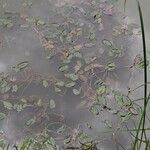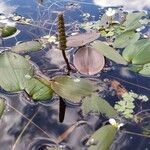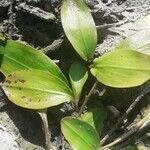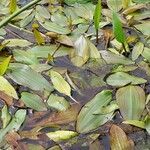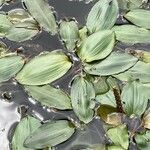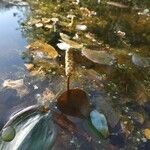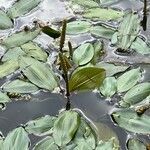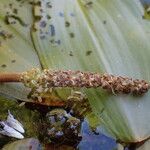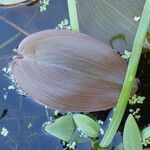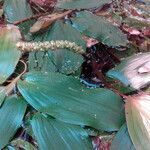Plants perennial, in fresh water. Rhizome slender to robust, terete. Stems slender to robust, terete, 1.5-2 mm in diam., usually simple or occasionally sparsely branched. Leaves dimorphic. Submerged leaves reduced to long, narrowly linear, obtuse phyllodes, 10-20 cm × 2-3 mm, often disappearing early, 1-3-veined. Floating leaves with axillary, convolute, often fibrous-persistent stipules 4-17 cm, petiolate, with a flexible discolored joint and distinct angle at top of petiole immediately below blade; blade opaque, ovate to broadly oblong-ovate or ovate-elliptic, 4-9 × 2.5-5 cm, leathery, 17-35-veined, base cuneate to subcordate, apex rounded or cuspidate. Spikes cylindric, 3-5 cm, densely flowered; peduncles 3-8 cm. Carpels 4. Fruit obovoid, 3.5-4.5 mm, abaxial keel obtuse, indistinct, with a short beak at tip. Fl. and fr. Jul-Oct. 2n = 52.
Stems 1–2 m, simple or sparingly branched; submersed lvs petiole-like, narrowly linear, 1–4 dm × 1–2 mm, with 3–5-obscure veins; floating lvs elliptic or elliptic-ovate, 5–10 × 2–4.5 cm, obtuse or bluntly short-cuspidate, rounded or subcordate at base, many-nerved; petiole usually much exceeding the blade and flexibly attached to it; stipules axillary, free, 4–10 cm, acute; peduncles 8–15 cm, usually thicker than the stem; spikes dense, cylindric, 2–5 cm; frs obovoid, turgid, with a rather loose, shiny pericarp, 3.5–5 mm, deeply wrinkled on each side, not keeled, or with an obscure dorsal keel; 2n=52. Ponds and slow streams; circumboreal, s. in Amer. to Pa., Ind., Io., and Calif.
A herb that grows in water. The leaves are of 2 types. The leaves under the water are small and narrow and 2 mm wide. The floating leaves are leathery and have long stalks. They are 5-9 cm long and 3-5 cm wide. The stalk is 6 cm long. The flower spike is 4.5 cm long.
